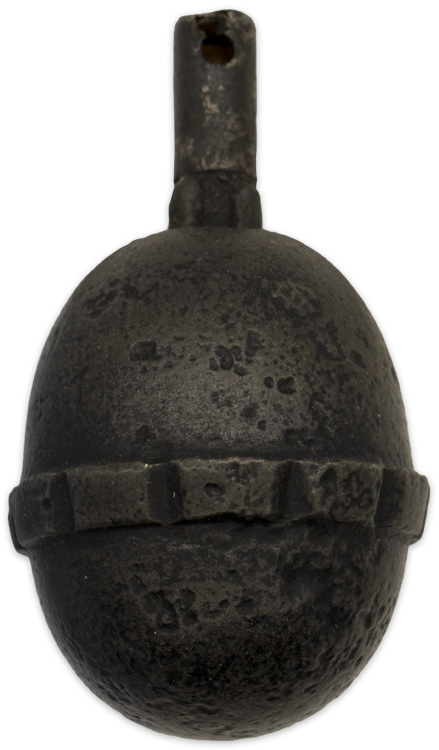

G002090 M1917 EGG GRENADE (n/A) (Inert/Deactivated).
BACKGROUND:
As WWI progressed, there was a need for a smaller grenade that could be thrown farther and carried in great numbers. Eierhandgranaten (egg hand grenades) are not very impressive, but they become interesting when you understand their tactical purpose. Development started in late 1916 which lead to the introduction of the cast iron M1917 Eierhandgranate. The small size and light weight allowed an average soldier to throw a Eierhandgranate approx. 40 meters, which meant Eierhandgranaten could be used in the offence as well as the defence. The Eierhandgranate was designed to use the same igniters as used on the Kugelhandgranate; both the M1913 brass igniter and the M1915 igniter. These igniters are all friction pull; pulling the wire that extends from the top sharply, ignites a compound which in turn ignites the fuse. These were igniting fuses, where a final flash from the bottom set off the main explosive charge after the delay fuse had burned through. 1st production M1917 Eierhandgranaten had smooth cast bodies which proved difficult to hold with wet or muddy hands so the design was quickly modified by adding adding a raised notched ridge around the center for a better grip. This is referred to as the M1917 Eierhandgranaten n/A (neuer Art = new model). Most web references claim that Eierhandgranaten were developed only because the Germans needed something lighter than the heavy Kugelhandgranaten (ball grenades)and less cumbersome than Stielhandgranaten (stick grenades) for trench raids but that is not entirely true; they were designed with tactical doctrine in mind. The actual use of the Eierhandgranate was to be used in conjunction with the larger grenades; they were carried in great numbers and an enemy tench was literally showered with these to keep the heads down of the enemy. Once in range, a larger Stielhandgranate would be thrown in which would kill everyone within the blast radius. Then once the Stormtroops were in the trench, they would clear each corner with a Stielhandgranate. If they came under opposition, they would once again carpet that spot with dozens of Eierhandgranaten which would have a devastating effect.PHYSICAL DESCRIPTION: M1917 Eierhandgranaten n/A with a zinc 7 second fuse. This example is the M1917 Eierhandgranaten n/A with a zinc 7 second fuse. Zinc from that period corrodes with oxygen, so all surviving zinc igniters are pitted to some degree. The hole on the side is a vent hole for the burning of the fuse.
Please note, due to Postal Regulations. De-activated firearms and Inert Ordnance may not be shipped outside of Canada.
GRADE **** PRICE $
To Order this item, please use one of the two e-mail addresses below to contact us. Please make sure to quote the item number in your e-mail
MILITARIA WANTED! If you have items for sale, please contact us. We specialize in selling single pieces and entire collections. Over 3 decades in the business and we do all the work for you. Get the best return for your investment.
-E-Mail Address pawmac@nbnet.nb.ca Or guild@nb.aibn.com
To return to the main page please CLICK below